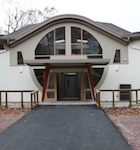At a Glance
Location
Philadelphia
Founded
1996
Employees
7
Specialties
Conscious community development and collaborative design work
Annual Sales
$500,000
Philadelphia is the largest city in Pennsylvania, and its rich legacy as one of the oldest cities in the United States and as a former national capital has led to significant historical-preservation efforts across entire municipal districts. The complex, landmark-heavy landscape has proven to be both an inspiration and a challenge for architects, and some have embraced it better than others. Mary Holland and Kurt Raymond, principals of Philadelphia’s CICADA Architecture/Planning, Inc., are constantly brainstorming new ways to execute projects while respecting the city’s past, and they’ve determined that community involvement is integral.
“We’re very strong contextualists without being slavish,” Holland says. “We take cues from the built environment and insert modern architecture that is informed by those cues.” CICADA often works and consults with private colleges, private developers, community groups, and nonprofit organizations, and they consider it a priority to stay informed—and keep others informed—about how to operate within Pennsylvania’s rich historical context.
As part of these efforts, CICADA invests a lot of time in the communities it works with. “One of our goals when founding the firm was supporting sustainable communities,” Raymond says. “Collaboration plays a major role in our methodology, so we often work with communities in the design process.”
The firm accomplishes this community collaboration in part via charette: a design process involving a dialogue in which all participants are given an equal voice. “This process allows stakeholders to develop ownership and provide input on the end result of a given project,” Raymond says.

CICADA’s recent work with nearby Swarthmore College serves as a good example of the firm’s ability to implement this collaborative and contextually sensitive approach. Established in 1864, Swarthmore is proactive in managing its buildings, and CICADA has worked with the school for more than a decade.
“Our work at Swarthmore began as an attempt to increase campus building accessibility,” Holland says, “though success with this has also led us to more visible projects on campus, [including the Old Tarble addition].” CICADA is now working with Mechanicsville, Pennsylvania–based CTC Construction to renovate the school’s Worth Student Health Center, originally designed by Vincent Kling. “Because Swarthmore and our other private university clients have strong historical contexts,” Raymond says, “one of our challenges is working with the community to respect this context while also producing something effectively contemporary.”
For CICADA, contemporaneity also requires the firm to pay acute attention to sustainability in all its projects. “Creating air-tight systems with a strong thermal envelope and efficient systems has become a default for housing—especially in our community-development scattered-site housing,” Raymond says. “The Energy Star standards add some expenses to the projects, but our clients are completely on board with them.”
“We were committed to sustainability from the outset,” Holland adds. “We always welcome the challenges of creating sustainable buildings.” CICADA also emphasizes the importance of sustainable standards to community-development-corporation clientele, and “the growth of LEED and Energy Star has been integral in facilitating these conversations,” Holland says.
The collective response to sustainability has proven to be one of CICADA’s most valuable aids in encouraging green building practices. And by promoting sustainability while maintaining a willingness to work within certain contexts—past, present, and future—Holland says, “We’re finding that it’s becoming much easier—and much more expected—that our projects correspond to sustainable standards.” ABQ



